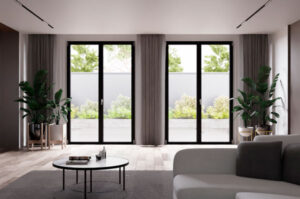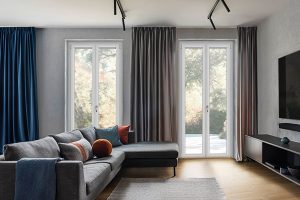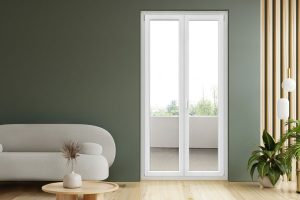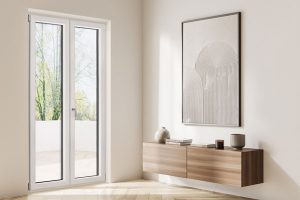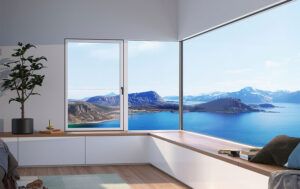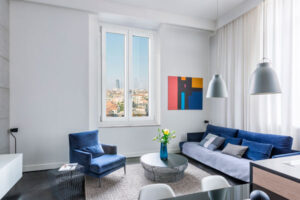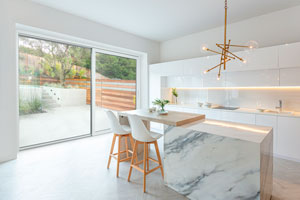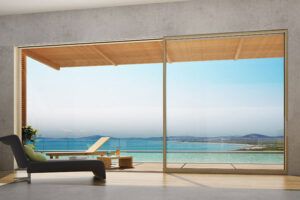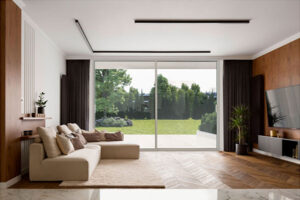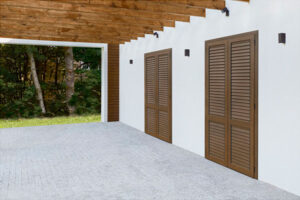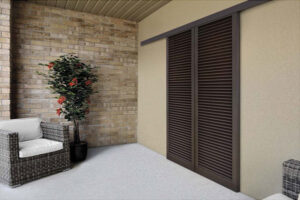Buying Guide
of the fixtures.
Those who are about to buy new fixtures are often confused because they do not have enough and clear information to understand the qualitative differences of the various windows. With our guide we want to fill this information gap.

Thermal
transmittance.
The coefficient of thermal transmittance (Uw) indicates how much energy (heat or refrigeration) disperses the frame through its surface.
The lower the coefficient Uw the greater the insulating power of the frame.
30% of energy expenditure in Italy is absorbed by our homes, which are responsible for about 27% of national greenhouse gas (CO2) emissions. Much of the heat and refrigeration is lost due to the so-called thermal bridges: windows, roof, cellar, exterior walls. These consumptions can be drastically reduced.
Replacing the old windows with new ones of I NOBILI can save up to 75% of energy, with considerable advantages for the family budget, for the environment and for living comfort.

Energy losses from a house built in the 1970s
With I Nobili windows you can reduce waste by up to 75%
A window I Nobili 0.97 compared to 4.8 of an old window

Wind
resistance.
Wind resistance according to the UNI EN 12210 standard is the ability of a window, subjected to strong pressures and/ or depressions, such as those caused by the wind, to maintain an acceptable deformation and retain its properties.
The frame is classified in 5 classes for wind pressure (1 to 5) and three classes for the relative front arrow (A,B,C), the combination of which provides the evaluation of the frame.
Passing the test guarantees great strength of the frame, minimal deformation even after large pressures, excellent resistance to wind blows, no breakage of the closing points, no sudden and uncontrolled opening of the windows and especially safety for users.
Acoustic
isolation.
Noise is an annoying, unpleasant or harmful sound and constitutes a type of pollution with implications that can cause psychophysical discomfort. The choice of window must be related to the intended use of the room in which the frame is to be inserted and to the external noise level. Choosing a window frame, which provides good sound insulation, means taking into account:
- external noise (dependent on the area, traffic, degree of urbanisation);
- the destination of the internal environment (can be home, office, hospital);
- the reference values according to the D.P.C.M. of 5/12/1997;
- the air permeability class of the door and window must be as high as possible.
It is important to note that the effectiveness of sound insulation depends on 3 factors: frame material, insulating glass and special attention must be paid during installation, to avoid acoustic bridges that cancel the performance of the window. The windows of I NOBILI, thanks to their sound-absorbing properties, allow you to restore peace of mind in private homes and working environments through state-of-the-art system components, special sound-insulating glass and applications executed to perfection.

INTENSITY SCALE
TYPE OF NOISE
PERCEPTION
20 dB
50 dB
70 dB
whispers
quiet apartment
noisy road
Fatigue
90 dB
100 dB
130 dB
hi fi – high volume TV
railway station
air engine
Pain threshold
Permeability
in the air.
The air permeability according to UNI EN 12207 is divided into four classes from 1 to 4 that determine the power of the window not to create air infiltration. An insulated window prevents heat loss in winter and cool in summer. All this translates into a considerable economic advantage and improved living comfort. Other advantages are, for example, the reduction of dust in the rooms, on the window sills, while the curtains remain clean longer. The entrance of smog and smells is also blocked.
Water
tightness.
The reference standard is: UNI EN 12208 provides 9 classes of differentiation: 1A to 9A (the highest). When the values of class 9 are exceeded, the performance is indicated by the letter E, associated with the value of the applied pressure (e.g. E750).
The water tightness test verifies the ability of the frame to prevent water infiltration under the action of a differential pressure between inside and outside. Passing the test guarantees the absence of water infiltration even in case of heavy rain accompanied by gusts of wind. It prevents damage to window sills and floors made of wood or other delicate material, carpets or carpets.


Resisting to
the impact.
The reference standard UNI EN 13049 provides 5 classes: from 1 to 5 (the highest).
The impact resistance test (also called soft and heavy body impact test) is a test that tends to assess the ability of the product to resist, without becoming dangerous for the end user, in case of sudden and accidental impacts of things, animals or people. Passing the test guarantees the safety of the frame for users.
Bearing capacity of
safety devices.
According to the reference standard UNI EN 1435-1 and UNI EN 14609 is the ability of the safety device to resists to mechanical stress. At the end of the conformity test, only if there is no degradation or failure, the frame is declared compliant.
Passing the test guarantees the operation of the frame, the safety of the user and the durability of the closing and locking mechanisms even under extreme and improper conditions of use of the frame, in particular with regard to opening limitation devices such as the opening shears of the open flap.

The radiative properties of glazing include three values: the solar factor, the light transmission factor and the light reflection. The values are expressed as a percentage.
The solar factor.
It represents the ratio between the amount of heat that passes through the glass and the amount that is reflected outside. The parameter that measures this behaviour, particularly important for evaluating the performance of glass under the action of thermal phenomena, is the solar factor (G) and depends on the thickness and characteristics of the glass.
Glasses with high solar factor allow a greater heat input.
However, in areas subject to high solar exposure, the use of low-solar glass is indicated, in order to limit the overheating of the premises (greenhouse effect).
The light transmission.
The light transmission factor (TL) indicates the amount of external light penetrating through the glass. The higher the percentage, the brighter the glasses and therefore the rooms in which they are installed.
The light reflection.
Light reflection (RL) is the percentage of light reflected by the glass (the rest is transmitted or absorbed by the glass).
It is denoted by Ug.
Expressed in W/m2k (Watt per m2 per degree kelvin), thermal transmittance indicates the level of thermal dispersion. The lower the Ug value, the greater the insulating power of the glass. By comparison, simple glass has a Ug coefficient of 5.8 compared to 2.8 for traditional insulating glass. An insulating glass, for example, may have a Ug coefficient of only 1.1.

